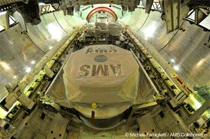Tracking down antimatter in the universe
28 Apr 2011
On April 29, 2011, the AMS-02 Alpha Magnetic Spectrometer will take off from the NASA launch site Cape Canaveral (Florida) to the International Space Station ISS on board the space shuttle Endeavour. AMS-02 will measure the composition of cosmic radiation with as yet unequaled precision. The focus will be on searching for antimatter which according to cosmological models occurs as a big bang relic. Besides, AMS-02 is expected to contribute to answering questions about the nature of dark matter. Scientists from Aachen and Karlsruhe are in charge of the German contribution to the experiment.
Being the last but one flight within the US Space Shuttle program, the last takeoff of the space shuttle Endeavour is scheduled for April 29, 2011. With the AMS-02 fundamental research experiment on board, the Endeavour will fly to the International Space Station ISS.
The AMS-02 Spectrometer
In close cooperation with the NASA, the AMS-02 detector, 4 m in length and approximately 7000 kg in weight, was designed in an international collaboration of 56 research institutes from 16 countries. Some of its essential components were built by RWTH Aachen and the Karlsruhe Institute of Technology (KIT). The research work is supported by the Space Administration of the German Aerospace Center (DLR) with funds from the Federal Ministry of Economics and Technology (BMWi).
Antimatter
The AMS-02 spectrometer is for cosmic rays what the Hubble Space Telescope is for the visible component of the universe. By precise measurement of the cosmic radiation, astroparticle physicists hope to track down the nature of the invisible ''dark'' matter and to ultimately answer the question as to wheter there are antimatter galaxies in the universe. Knowing that in the dense plasma of the early universe, virtually the whole matter of the universe came into existence a few minutes after the big bang, one is left with two exciting puzzles: Were identical amounts of antimatter produced at the same time, as expected from accelerator experiments? Was that antimatter destroyed completely through its annihilation with matter?
''If AMS-02 succeeded in detecting just one single antihelium nucleus, we would have strong evidence for the existence of galaxies made up of antimatter,'' explains Prof. Wim de Boer who teaches Cosmology and Particle Physics at KIT and heads the AMS group. Considering that matter and antimatter annihilate each other, such ''antigalaxies'', however, are bound to be far away from the known galaxies. ''It is conceivable,'' de Boer explains ''that larger antimatter quantities were catapulted in a different direction and that a reaction with the visible matter was prevented in that way. It would be even more spectacular to find an anticarbon nucleus consisting of six antiprotons plus six antineutrons because such heavy nuclei cannot be produced in collisions but can only be ''baked'' in collapsing stars from antimatter.''
Dark Matter
So far, dark matter particles have been perceived only through their gravitational force. Since
 |
| Space shuttle Endeavour's payload bay. (Photo: NASA/AMS) |